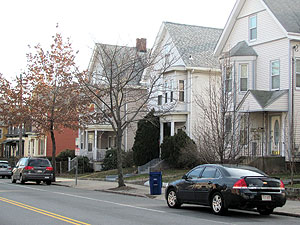
Historic new ordinance uses national best practices to implement SomerVision.
Somerville is the first and largest municipality in the Boston metropolitan region to adopt a citywide form-based code.
After over seven years of research and analysis, hundreds of community meetings, multiple public hearings and extensive review by the former Board of Aldermen and current City Council, Somerville officially has a new zoning ordinance. On December 12, 2019, the City Council voted to approve the administration’s proposed new zoning ordinance, making this the first major overhaul of zoning in Somerville since 1990, and an update of some regulatory elements that have existed since zoning was first adopted in 1924.
“For years we have steadfastly worked, as a community, to ensure that we have the best possible zoning ordinance that meets the goals and expectations of our residents and businesses, that enables us to expand affordable housing, jobs, development, and so much more to move our community forward while ensuring residents of all backgrounds can afford to stay, and build their homes and businesses here,” said Mayor Joseph A. Curtatone. “I want to thank the Council for taking a very long, hard look at our proposal and making carefully considered revisions to meet the community’s requests and needs. And I want to thank current SPCD Director George Proakis, his predecessor Michael Glavin, our entire Planning staff, and particularly Senior Planner and principal author Dan Bartman who has been the driving force of this zoning overhaul since its inception in 2012. This has been a labor of love, and I am thrilled to finally say we have an ordinance that is progressive, that makes sense, and that keeps Somerville on the move.”
Somerville is the first and largest municipality in the Boston metropolitan region to adopt a citywide form-based code (FBC) that also incorporates best practices from performance-based and use-based zoning to achieve more than 180 objectives of SomerVision 2030, the City’s comprehensive Master Plan first adopted in 2012.
“This effort was one of the most significant undertakings by the City Council in decades and we are grateful for the collaboration from the administration and the invaluable input from the community throughout. I am extremely proud of the work that my colleagues and I have put in to create an ordinance designed to harness the powerful forces of change in our City in a way that ensures that our shared values are considered first,” said Ward 6 City Councilor Lance Davis, who serves as Chair of the Council’s Land Use Committee. “We’ve all been eager to see this zoning passed but over the last several years we’ve worked hard to make sure that we got it right. This ordinance is not an end point but rather a new framework that will allow us to continue to fight for those values.”
Among the vast array of language, regulatory, and procedural improvements, the new 552-page ordinance:
· Uses clear, simple language to make zoning understandable to a broad audience.
· Includes illustrations, graphics, and photos to help users visualize the standards.
· Regulates development through standards for 23 different building types.
· Permits common home improvements such as dormers, bay windows, rear additions, porches, and other ‘building components’ by-right.
· Permits backyard cottages, including tiny houses.
· Provides graduated density bonuses for larger lots, net zero ready buildings, and 100% affordable housing buildings.
· Requires the majority of new development to provide 20% of new units as affordable dwelling units.
· Establishes building sustainability standards to reach Somerville’s commitment to be carbon neutral by 2050.
· Regulates land use through 62 simplified use categories compared to the over 250 individual uses of the former ordinance.
· Requires a special permit for all ‘formula businesses.’
· Establishes a ‘Fabrication District’ and an ‘Arts & Creative Enterprise’ use category to support the creative economy, from individual artists to technology start-ups.
· Establishes New England’s first environmental sustainability performance standard for urban landscapes: the Somerville Green Score.
· Requires outdoor lighting to be dark sky compliant.
· Repeals minimum parking requirements for the majority of the city.
· Establishes parking maximums in all areas within walking distance to the MBTA’s Red, Orange, and Green Line rapid transit stations.
· Requires new development to widen sidewalks and prohibits curb cuts on designated ‘pedestrian streets.’
· Requires parking in higher density districts to be commercial parking facilities.
· Requires accessory parking to be ‘unbundled’ from the cost of housing and commercial space.
· Establishes robust minimum bicycle parking requirements.
· Requires higher density buildings and larger businesses to submit Mobility Management Plans and implement transportation demand management programs & services.
· Entitles mixed-use, transit-oriented, high density transformational development akin to Assembly Square through a number of Overlay Districts and a Master Plan Special Permit approval process.
· Establishes a new Urban Design Commission to review how the proposed design of new development impacts Somerville’s public realm.
The new Somerville Zoning Ordinance and Zoning Atlas go into effect immediately. More information is available at www.somervillezoning.com.















Finally.
“Establishes a ‘Fabrication District’ and an ‘Arts & Creative Enterprise’ use category to support the creative economy, from individual artists to technology start-ups.”
What on earth is this?
Congratulations to the City of Somerville, SPCD Director, George Proakis, and Senior Planner, Dan Bartman for a job well-done! You have adopted a model form-based code that can serve as an example for other communities across Massachusetts and throughout the country.
Marta Goldsmith
Executive Director
Form-Based Codes Institute at Smart Growth America